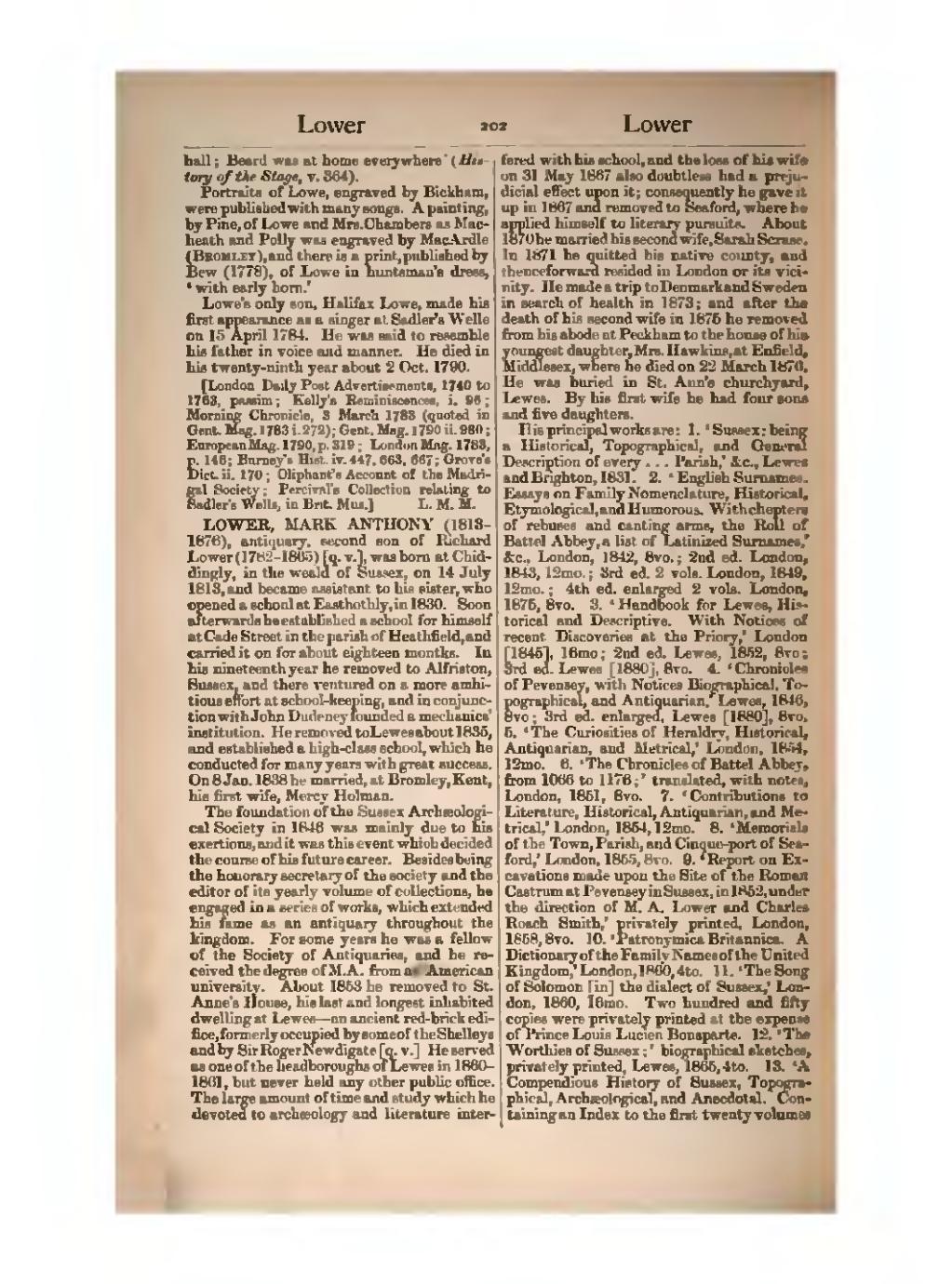hall; Beard was at home everywhere’ (History of the Stage, v. 364).
Portraits of Lowe, engraved by Bickham, were published with many songs. A painting, by Pine, of Lowe and Mrs. Chambers as Macheath and Polly was engraved by MacArdell (Bromley), and there is a print, published by Bew (1778), of Lowe in huntsman's dress, ‘with early horn.’ Lowe's only son, Halifax Lowe, made his first appearance as a singer at Sadler's Wells on 15 April 1784. He was said to resemble his father in voice and manner. He died in his twenty-ninth year about 2 Oct. 1790.
[London Daily Post Advertisements, 1740 to 1763; passim; Kelly's Reminiscences, i. 96; Morning Chronicle, 3 March 1783 (quoted in Gent. Mag. 1783 i. 272); Gent. Mag. 1790 ii. 980; European Mag. 1790, p. 319; London Mag. 1783, p. 146; Burney's Hist. iv. 447, 663, 667; Grove's Dict. ii. 170; Oliphant's Account of the Madrigal Society; Percival's Collection relating to Sadler's Wells, in Brit. Mus.]
LOWER, MARK ANTHONY (1813–1876), antiquary, second son of Richard Lower (1782–1865) [q. v.], was born at Chiddingly, in the weald of Sussex, on 14 July 1813, and became assistant to his sister, who opened a school at Easthothly, in 1830. Soon afterwards he established a school for himself at Cade Street in the parish of Heathfield, and carried it on for about eighteen months. In his nineteenth year he removed to Alfriston, Sussex, and there ventured on a more ambitious effort at school-keeping, and in conjunction with John Dudeney founded a mechanics' institution. He removed to Lewes about 1835, and established a high-class school, which he conducted for many years with great success. On 8 Jan. 1838 he married, at Bromley, Kent, his first wife, Mercy Holman.
The foundation of the Sussex Archæological Society in 1846 was mainly due to his exertions, and it was this event which decided the course of his future career. Besides being the honorary secretary of the society and the editor of its yearly volume of collections, he engaged in a series of works, which extended his fame as an antiquary throughout the kingdom. For some years he was a fellow of the Society of Antiquaries, and he received the degree of M.A. from an American university. About 1853 he removed to St. Anne's House, his last and longest inhabited dwelling at Lewes—an ancient red-brick edifice, formerly occupied by some of the Shelleys and by Sir Roger Newdigate [q. v.] He served as one of the headboroughs of Lewes in 1860–1861, but never held any other public office. The large amount of time and study which he devoted to archæology and literature interfered with his school, and the loss of his wife on 31 May 1867 also doubtless had a prejudicial effect upon it; consequently he gave it up in 1867 and removed to Seaford, where he applied himself to literary pursuits. About 1870 he married his second wife, Sarah Scrase. In 1871 he quitted his native county, and thenceforward resided in London or its vicinity. He made a trip to Denmark and Sweden in search of health in 1873; and after the death of his second wife in 1875 he removed from his abode at Peckham to the house of his youngest daughter, Mrs. Hawkins, at Enfield, Middlesex, where he died on 22 March 1876. He was buried in St. Ann's churchyard, Lewes. By his first wife he had four sons and five daughters.
His principal works are:
- ‘Sussex: being a Historical, Topographical, and General Description of every … Parish,’ &c., Lewes and Brighton, 1831.
- ‘English Surnames. Essays on Family Nomenclature, Historical, Etymological, and Humorous. With chapters of rebuses and canting arms, the Roll of Battel Abbey, a list of Latinized Surnames,’ &c., London, 1842, 8vo.; 2nd ed. London, 1843, 12mo.; 3rd ed. 2 vols. London, 1849, 12mo.; 4th ed. enlarged 2 vols. London, 1875, 8vo.
- ‘Handbook for Lewes, Historical and Descriptive. With Notices of recent Discoveries at the Priory,’ London [1845], 16mo; 2nd ed. Lewes, 1852, 8vo; 3rd ed. Lewes [1880], 8vo.
- ‘Chronicles of Pevensey, with Notices Biographical, Topographical, and Antiquarian,’ Lewes, 1846, 8vo; 3rd ed. enlarged, Lewes [1880], 8vo.
- ‘The Curiosities of Heraldry, Historical, Antiquarian, and Metrical,’ London, 1854, 12mo.
- ‘The Chronicles of Battel Abbey, from 1066 to 1176;’ translated, with notes, London, 1851, 8vo.
- ‘Contributions to Literature, Historical, Antiquarian, and Metrical,’ London, 1854, 12mo.
- ‘Memorials of the Town, Parish, and Cinque-port of Seaford,’ London, 1855, 8vo.
- ‘Report on Excavations made upon the Site of the Roman Castrum at Pevensey in Sussex, in 1852, under the direction of M. A. Lower and Charles Roach Smith,’ privately printed, London, 1858, 8vo.
- ‘Patronymica Britannica. A Dictionary of the Family Names of the United Kingdom,’ London, 1860, 4to.
- ‘The Song of Solomon [in] the dialect of Sussex,’ London, 1860, 16mo. Two hundred and fifty copies were privately printed at the expense of Prince Louis Lucien Bonaparte.
- ‘The Worthies of Sussex;’ biographical sketches, privately printed, Lewes, 1865, 4to.
- ‘A Compendious History of Sussex, Topographical, Archæological, and Anecdotal. Containing an Index to the first twenty volumes
